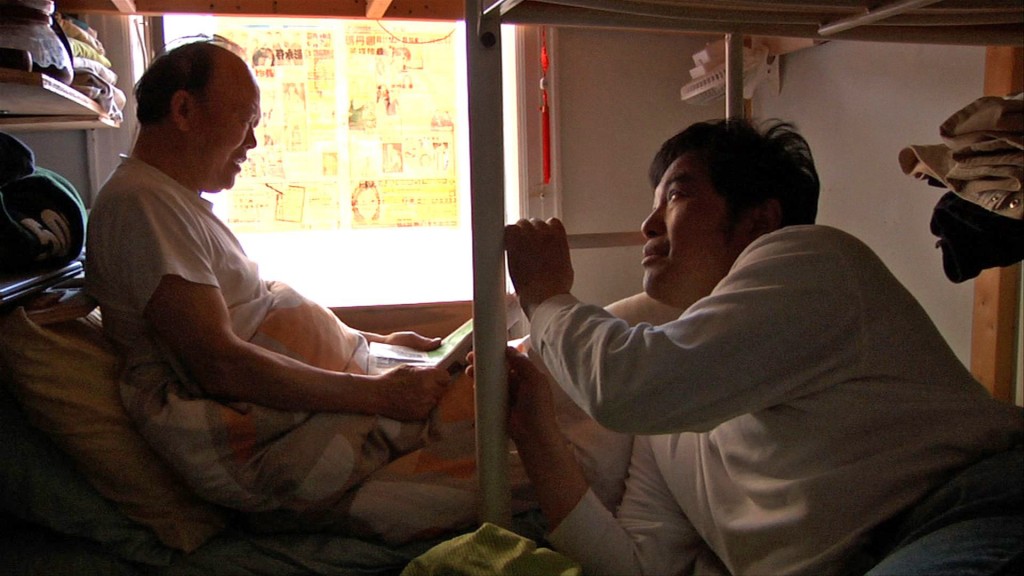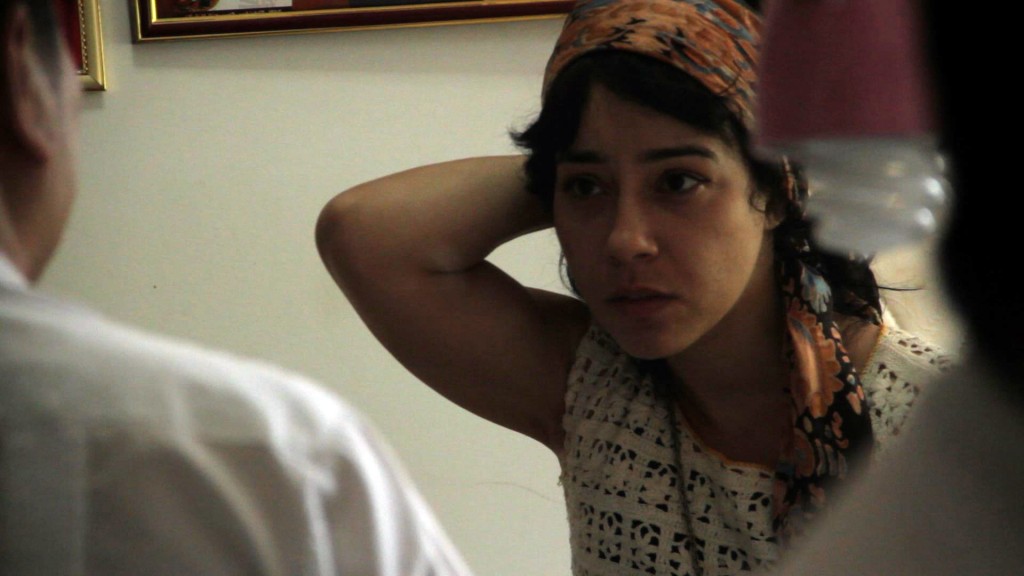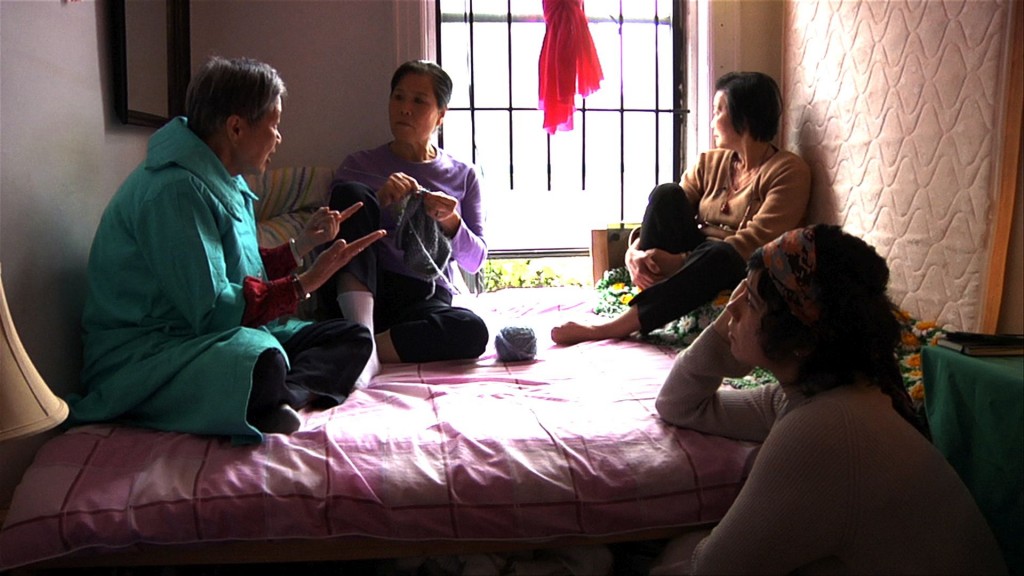64 min. – HD Video, 16mm, Super-8mm – Stereo & 5.1 Surround – 2013
In Mandarin, Spanish & English with English subtitles
Synopsis:
Immigrant residents of a “shift-bed” apartment in the heart of New York City’s Chinatown share their stories of personal and political upheaval. As the bed transforms into a stage, the film reveals the collective history of the Chinese in the United States through conversations, autobiographical monologues, and theatrical movement pieces. Shot in the kitchens, bedrooms, wedding halls, cafés, and mahjong parlors of Chinatown, this provocative hybrid documentary addresses issues of privacy, intimacy, and urban life.
Director’s Statement:
I’ve spent most of my life as an artist thinking about how to convey my observations of the world around me in the visual and aural language of film. I experiment with my perception of reality by embracing an associative, non-literal approach to images, and it is through this artistic exploration that I grapple with the natural, social, cultural and political phenomena that I witness through the lens of my camera. I began the Your Day is My Night project in late 2010 when I was talking with a relative on his 90th birthday. A Brooklyn resident for his entire life, Uncle Bob has haunting memories of December 16, 1960 when a jet crashed near his Brooklyn home. Trying to imagine the devastation in this busy neighborhood, I asked him how many people on the ground had died. ‘It was hard to know because there were so many hot bed houses in that area. They all burned and no one knew precisely who lived there.’

Kam Yin Tsui and Yun Xiu Huang in “Your Day is My Night”
What are hot bed houses? I asked him. ‘Those are homes for poor people who work and can’t afford to rent their own apartments. They share beds in shifts.’ I reconstructed the moment of the crash, creating a mental image of the inhabitants of these apartments as they tried to gather their few personal possessions and escape the fire. Which unlucky person would awake from a deep sleep after a long shift at the port to the sound of the crash and the heat of the fire?
After that conversation, I discovered that 19th Century photographer Jacob Riis documented numerous examples of these beds, and it is through his lens that I was able to begin my research. In Riis’ How the Other Half Lives, he exposed to the rest of America the poor, immigrant experience he witnessed in downtown New York City. I later read The Snakehead: An Epic Tale of the Chinatown Underworld and the American Dream by Patrick Radden Keefe to give me a more current sense of the situation in current day Chinatown.
I think of the bed as an extension of the earth. For most of us, we sleep on the same mattress every night; our beds take on the shape of our bodies, like a fossil where we leave our mark for posterity. During the Revolutionary War, George Washington slept in many borrowed beds and now, hundreds of years later, his brief presence is celebrated from one New England town to the next: ‘George Washington Slept Here’ has a kind of strange signification and prestige. But for transients, people who use hotels, and the homeless a bed is no more than a borrowed place to sleep. An animal that borrows its home from another species is called an inquiline, and in Spanish inquilina is the word for a renter. Conceptual artist and sculptor Félix González-Torres photographed a series of empty, unmade beds to commemorate the life and death of his partner, as if the very sheets that remained could remind him and us of the body and the man he had loved.

Veraalba Santa in “Your Day is My Night”
After 25 years of making experimental documentaries, I learned something that turned all my ideas about filmmaking upside down. While working on Your Day is My Night, I came to see that every time I asked a person to talk in front of my camera, they were performing for me rather than revealing something completely honest about their lives. The very process of recording guaranteed that some aspect of the project would be artificial. I had to think of a way to change that, so I decided to invite them to work with me to make the film, to become my collaborators. This process began in 2011 and it’s changed the way I make movies. This change in my process of filmmaking has taken me even deeper into a new type of collaborative filmmaking, one that not only explores the experiences of my subjects, but also invites them to participate in the construction of a film about their lives.
In 2011, I began writing, researching, and shooting material for my new ‘bed project’ in the Chinatown neighborhood of New York City. I found a group of non-professional Chinese performer/participants (ages 58 – 78) and worked almost weekly with them over a period of a year and a half. During our workshops, they each exchanged their own stories around domestic life, immigration and personal-political upheaval. None of these people had ever worked in this cross-cultural way, so it was these taped process-oriented conversations that would enhance our audience’s sense of the bed – experienced and imagined from profoundly different viewpoints. Next, a written script emerged from our months of shooting documentary images and interviews. During this phase of production, I was very much inspired by the austere yet playful dramaturgy of French theater director Ariane Mnouchkine (Theatre du Soleil), Augusto Boal’s Theater of the Oppressed, the Wooster Group’s high-tech stage shenanigans, and Chinese director Jia Zhangke’s mixing of artifice and truth.
The material I collected during these interviews is the basis for the monologues in Your Day is My Night. Throughout our period of shooting, I guided my performers through visual scenarios that reveal a bed as a stage on which people manifest who they are at home and who they are in the world. Drawing from both documentary and improvised fictions, we worked in two different actual shift-bed apartments in New York City’s Chinatown.

Sheut Hing Lee, Linda Chan, Ellen Ho & Veraalba Santa in “Your Day is My Night”
Our entire cast presented Your Day is My Night as a live film performance at St. Nicks Alliance in Greenpoint, Brooklyn, the Chinatown branch of the New York Public Library, Proteus Gowanus Interdisciplinary Arts Gallery in Brooklyn, The Performance Project at University Settlement in Manhattan and Maysles Cinema in Harlem. Beginning with the premier of our completed hybrid documentary at the Museum of Modern Art in 2013, I invite our entire cast every time I show the film in New York City. In this way, they too remain a part of the life of the movie as we engage with our audiences and listen to their interpretations of the film we created together. – LS
Credits:
Featuring: Yi Chun Cao, Linda Y.H. Chan, Chung Qing Che, Ellen Ho, Yun Xiu Huang, Sheut Hing Lee, Kam Yin Tsui, & Veraalba Santa
Director: Lynne Sachs
Co-producer, Cinematographer, Editor: Sean Hanley
Original Music & Additional Sound Design: Stephen Vitiello
Cinematographer: Ethan Mass
Writing: Rojo Robles, Lynne Sachs
Translations and Production Managing: Catherine Ng, Jenifer Lee
Sound Recording: Amanda Katz, Jeff Sisson
Sound Mix: Damian Volpe
Additional Editing and Translating: Bryan Chang
16mm Color Negative Hand-Processing: Joshua Lewis
Titles: Rachel Melman
